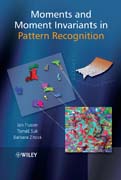
Moments and moment invariants in pattern recognition
Flusser, Jan
Zitova, Barbara
Suk, Tomas
Moments as projections of an image's intensity onto a proper polynomial basis can be applied to many different aspects of image processing. These includeinvariant pattern recognition, image normalization, image registration, focus/defocus measurement, and watermarking. This book presents a survey of both recent and traditional image analysis and pattern recognition methods, based on image moments, and offers new concepts of invariants to linear filtering and implicit invariants. In addition to the theory, attention is paid to efficient algorithms for moment computation in a discrete domain, and to computational aspects of orthogonal moments. The authors also illustrate the theory through practical examples, demonstrating moment invariants in real applications acrosscomputer vision, remote sensing and medical imaging. This title presents a systematic review of the basic definitions and properties of moments covering geometric moments and complex moments. It considers invariants to traditional transforms - translation, rotation, scaling, and affine transform - from a new point of view, which offers new possibilities of designing optimal sets of invariants. It reviews and extends a recent field of invariants with respect to convolution/blurring. It introduces implicit moment invariants as a tool for recognizing elastically deformed objects. It compares various classes of orthogonal moments (Legendre, Zernike, Fourier-Mellin, Chebyshev, among others) and demonstrates their application to image reconstruction from moments. It offers comprehensive advice on the construction of various invariants illustrated withpractical examples. It includes an accompanying website providing efficient numerical algorithms for moment computation and for constructing invariants of various kinds, with about 250 slides suitable for a graduate university course. "Moments and Moment Invariants in Pattern Recognition" is ideal for researchers and engineers involved in pattern recognition in medical imaging, remote sensing, robotics and computer vision. Post graduate students in image processing and pattern recognition will also find the book of interest. INDICE: Authors' biographies Preface Acknowledgments 1 Introduction to moments 1.1 Motivation 1.2 What are invariants? 1.3 What are moments? 1.4 Outlineof the book References 2 Moment invariants to translation, rotation and scaling 2.1 Introduction 2.2 Rotation invariants from complex moments 2.3 Pseudoinvariants 2.4 Combined invariants to TRS and contrast changes 2.5 Rotation invariants for recognition of symmetric objects 2.6 Rotation invariants via image normalization 2.7 Invariants to nonuniform scaling 2.8 TRS invariants in3D 2.9 Conclusion 3 Affine moment invariants 3.1 Introduction 3.2 AMIs derived from the Fundamental theorem 3.3 AMIs generated by graphs 3.4 AMIs via image normalization 3.5 Derivation of the AMIs from the Cayley-Aronhold equation 3.6 Numerical experiments 3.7 Affine invariants of color images 3.8 Generalization to three dimensions 3.9 Conclusion Appendix References 4 Implicit invariants to elastic transformations 4.1 Introduction 4.2 General moments under a polynomial transform 4.3 Explicit and implicit invariants 4.4 Implicit invariants as a minimization task 4.5 Numerical experiments 4.6 Conclusion References 5 Invariants to convolution 5.1 Introduction 5.2 Blur invariants for centrosymmetric PSFs5.3 Blur invariants for N-fold symmetric PSFs 5.4 Combined invariants 5.5 Conclusion Appendix References 6 Orthogonal moments 6.1 Introduction 6.2 Moments orthogonal on a rectangle 6.3 Moments orthogonal on a disk 6.4 Object recognition by ZMs 6.5 Image reconstruction from moments 6.6 Three-dimensional OG moments 6.7 Conclusion References 7 Algorithms for moment computation 7.1 Introduction 7.2 Moments in a discrete domain 7.3 Geometric moments of binary images 7.4 Geometric moments of graylevel images 7.5 Efficient methods for calculatingOG moments 7.6 Generalization to n dimensions 7.7 Conclusion References 8 Applications 8.1 Introduction 8.2 Object representation and recognition 8.3 Imageregistration 8.4 Robot navigation 8.5 Image retrieval 8.6 Watermarking 8.7 Medical imaging 8.8 Forensic applications 8.9 Miscellaneous applications 8.10 Conclusion References 9 Conclusion Index
- ISBN: 978-0-470-69987-4
- Editorial: John Wiley & Sons
- Encuadernacion: Cartoné
- Páginas: 312
- Fecha Publicación: 01/10/2009
- Nº Volúmenes: 1
- Idioma: Inglés
